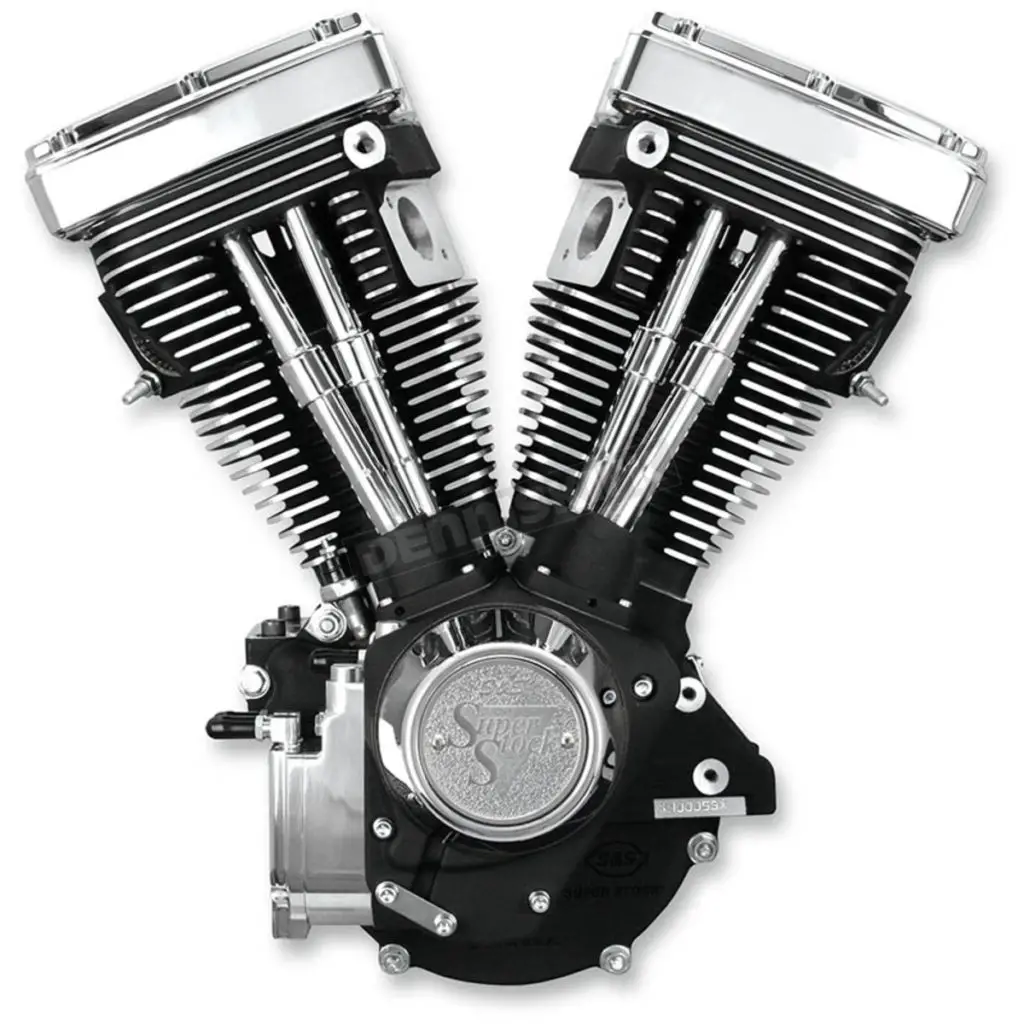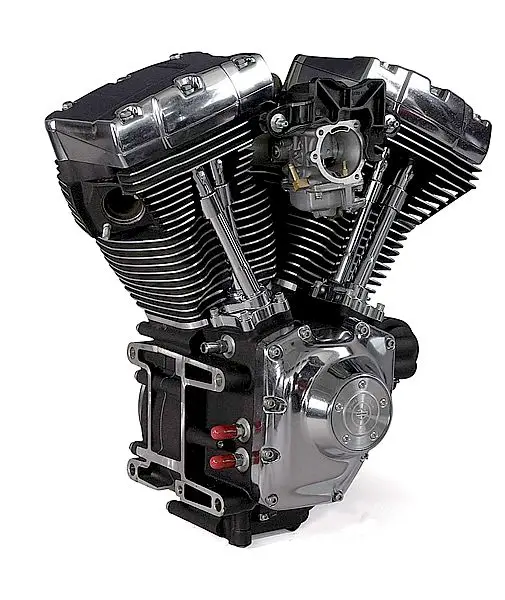If you’re a fan of Harley Davidson motorcycles, then you know that there’s nothing quite like the sound of a big V-twin engine. In this article, we’ll take a look at the different engine sizes Harley has used over the years.
We’ll also chart out the timeline of Harley engines, so you can see how they’ve evolved over time. So sit back and enjoy this trip down memory lane!

Quick Article Navigation
Harley Davidson Engines Timeline
Let’s talk about the different engine sizes Harley Davidson has used over the years.
The 45° F-Head V-Twin

The F-Head engine, introduced in 1903, was the first attempt by Harley-Davidson to increase engine size. The F-Head used an intake valve located in the cylinder head, while the exhaust valve was located in the cylinder. This arrangement allowed for a larger engine but was inefficient and difficult to maintain.
In 1907, Harley-Davidson built a prototype V-twin engine with the cylinders mounted in a “V” configuration. The V-twin had two benefits over the F-head: it was more efficient and easier to maintain. The V-twin made its production debut in 1911, quickly becoming the signature engine for Harley-Davidson motorcycles.
The 45° angle of the “V” was chosen because it allowed the engine to be used in the same frame as a single-cylinder engine. The V-twin also had mechanical exhaust valves, allowing higher RPMs and more power.
The 45° V-twin’s appearance laid the groundwork for today’s Harley twin. It was refined and enhanced rather than extensively modified.
The basic architecture remains in use after more than a century, making it one of the longest-running engine designs in history.
The Eight-Valve
The Eight-Valve is a V-twin engine that was used in Harley-Davidson’s factory race team. The engine was successful in races and carved a massive reputation for the company.
The engine has two inlet valves and two exhaust valves per cylinder, allowing gases to flow into and out of the engine in greater quantity than in the traditional four-valve V-twin. The resulting increase in power was exactly what was needed for a successful racing engine.
Harley wasn’t the first manufacturer to use this technology, but the company’s eight-valve racers carved a massive reputation based on numerous racing victories.
The Flathead V-Twin

The flathead, or side-valve, the engine has a long history dating back to the early days of automobile production. Though it is not as efficient as its counterpart, the overhead valve engine, it is much simpler to construct and maintain. This made it the engine of choice for many manufacturers in the early part of the twentieth century.
The flathead was particularly popular in America, which powered cars and motorcycles. The Flathead V-Twin, introduced in 1929, was especially iconic. It remained in production until 1973, when it was finally replaced by a more modern design.
The flathead engine may no longer be in use today, but its simple design and enduring popularity are a testament to its lasting appeal.
The Knucklehead

The Knucklehead engine was introduced in 1936 and came with two significant new features.
The first was overhead valves, which boosted power from the V-twin unit, and the second was a single camshaft arrangement that would be used on Harley’s big twins for the next 60 years.
The Knucklehead was also the first Harley-Davidson to incorporate a recirculating oil system, where oil was constantly fed through the engine rather than just burned off.
The Knucklehead was a powerful and reliable engine that set the standard for Harley-Davidson’s big twins for decades to come. Thanks to its innovative design, motorcycle enthusiasts still revere the Knucklehead.
The Panhead

The Panhead was an upgraded version of the Knucklehead, and it featured a number of significant changes.
The most notable change was the fully enclosed valve gear, which made the engine quieter and cleaner. The hydraulic valve-lifters also cut down on maintenance.
The new aluminum cylinder heads were capped with large pan-shaped rocker covers, which gave the bike its name.
The Panhead was a more refined and polished machine than the Knucklehead, and it quickly became one of the most popular motorcycles on the market.
Thanks to its numerous improvements, the Panhead cemented Harley-Davidson’s place as one of the leading motorcycle manufacturers in the world.
The Shovelhead

The Shovelhead was introduced in 1966 and was notable for its cast-alloy rocker boxes, which gave the engine its distinctive shape.
The engine’s bottom end was almost identical to that on the Panhead until a revamp in 1970 changed the electrical supply from the generator to alternator power.
The Shovelhead was quieter, cleaner, more efficient, and a bit more powerful than the Panhead.
The engine was used in various Harley-Davidson models until 1984 when the Evolution engine replaced it.
The Shovelhead is still popular with collectors and enthusiasts today.
The Evolution

The Evolution engine, or “Evo,” as it is commonly known, was introduced in 1984 and quickly became the most popular engine used by Harley-Davidson.
The Evo was significantly smaller and lighter than the Shovelhead, producing more power thanks to its overhead-valve design.
The engine used a traditional 45-degree, air-cooled V-twin layout with two overhead valves per cylinder.
It also featured cast-iron block and cylinder heads, making it more durable than its predecessor.
The Evolution engine remained in production until 1999, when it was replaced by the Twin Cam 88.
Despite being out of production for nearly 20 years, the Evo is still considered one of the best engines ever produced by Harley-Davidson.
The Twin Cam 88

The Twin Cam 88 was introduced in 1999 and quickly became the new standard for Harley-Davidson engines. The Twin Cam is the engine that powers most of Harley’s line-up from 1999 to the present.
It was a clean, more integrated design than the Evolution engine that preceded it and provided a platform for future development. The Twin Cam departed from Harley’s traditional 45° overhead-valve layout but still relied on the trusty overhead-valve layout.
The Twin Cam provided a nod to the future with its sophisticated fuel-injection and ignition system, but engine capacity only grew from 88cu.in. to 96cu.in. The 103cu.in. The version came later.
Today, the Twin Cam is the engine of choice for most Harley models.
The V-Rod (Revolution)

The V-Rod was a new model from Harley-Davidson for the 2001 model year. The main changes from previous models were a 60° cylinder angle (instead of 45°), liquid cooling, and overhead valves.
The V-Rod also had side-by-side connecting rods (previous models had “knife and fork” connecting rods). The V-Rod was developed with help from Porsche, who had experience with high-performance engines.
The V-Rod successfully increased power output while maintaining the characteristic sound of a Harley V-twin engine. The V-Rod remained in production until 2017 when it was discontinued due to declining sales.
The Milwaukee-Eight (Wafflehead)

The Milwaukee-Eight is the latest engine from Harley-Davidson, introduced in 2017. The main changes from previous models are a larger displacement (107cu.in or 114cu.in), four valves per cylinder, and liquid cooling.
The Milwaukee-Eight also has a new firing order, giving it a smoother and more balanced sound. The engine is named after Harley-Davidson’s hometown of Milwaukee, Wisconsin.
The Milwaukee-Eight is the most powerful and most advanced engine ever produced by Harley-Davidson. It is currently used in various models, including the Touring, Softail, and Dyna families.
Harley Davidson Engine Size Chart
| Engine Name | Volume CI (CC) |
|---|---|
| F-Head | 61ci & 74 ci (1000cc &1210cc) |
| Flathead | 45ci & 74ci (737cc & 1212cc) |
| Knucklehead | 61ci & 74ci (983cc &1212cc) |
| Panhead | 61ci & 74ci (983cc & 1200cc) |
| Shovelhead | 74ci & 80ci (1212cc & 1343cc) |
| Evolution | 80ci (1343cc) |
| Twin Cam 88 | 88ci (1442cc) |
| Twin Cam 88B | 88ci (1442cc) |
| Twin Cam 95 | 95ci (1550cc) |
| Twin Cam 96 | 96ci (1584cc) |
| Twin Cam 103 | 103ci (1690cc) |
| Twin Cam 110 | 110ci (1800cc) |
| Milwaukee Eight 107 (Standard) | 107ci (1746cc) |
| Milwaukee Eight 107 | 107ci (1746cc) |
| Milwaukee Eight 114 | 114ci (1868cc) |
| Milwaukee Eight 117 | 117ci (1923cc) |
| Evolution (Sportster / Small V-Twin) | 54ci & 73ci (883cc & 1200cc) |
| V-Rod (Revolution) | 76ci (1247cc) |
Frequently Asked Questions
What distinguishes a Harley-Davidson engine from other engines?
Two main things make a Harley-Davidson engine different from other motorcycle engines.
The first is the design of the engine itself. Harley engines are V-twin engines, meaning two cylinders are arranged in a V shape. This configuration gives the engine a unique sound and makes it more powerful than other motorcycle engines.
The second thing that makes a Harley engine different is how the pistons fire. Most motorcycle engines have four strokes (intake, compression, combustion, and exhaust), but Harley engines only have two strokes (intake and combustion). This makes the engine simpler and easier to maintain, but it also makes it less fuel-efficient.
What is the biggest Harley-Davidson engine?
The largest engine that Harley-Davidson has ever produced is the Milwaukee-Eight, which has a displacement of 107cu.in or 114cu.in. The Milwaukee-Eight is the most powerful and most advanced engine ever produced by Harley-Davidson.
How many Harley Davidson engine sizes are there?
Harley-Davidson has produced various engine sizes over the years, from the small Twin Cam 88 to the large Milwaukee-Eight. The most popular engine size is the Twin Cam, which powers most of Harley’s line-up from 1999 to the present.
What is Harley Davidson’s most powerful engine?
The Milwaukee-Eight is the most powerful engine ever produced by Harley-Davidson. It has a displacement of 107cu.in or 114cu.in, and it is used in various models, including the Touring, Softail, and Dyna families.
What Harley Davidson models have the Milwaukee Eight engine?
The Milwaukee-Eight is used in various models, including the Touring, Softail, and Dyna families.
What Harley Davidson models have the Twin Cam engine?
The Twin Cam was used in most Harley models from 1999 to 2006. It is currently used in a limited number of models, including the Sportster and Dyna families.
When was the Harley Davidson V-Rod discontinued?
The V-Rod was discontinued in 2017 due to declining sales.
What Harley Davidson engines are liquid-cooled?
The V-Rod and Milwaukee-Eight are both liquid-cooled engines.
What is Harley Davidson’s firing order?
The firing order of a Harley-Davidson engine is different from other motorcycle engines—the cylinders fire in a specific order, which gives the engine a unique sound.
What is Harley Davidson’s displacement?
The displacement of a Harley-Davidson engine refers to the total volume of air and fuel that the engine can draw in and compress during one cycle. The most common displacements are 88cu.in, 96cu.in, 103cu.in, and 107cu.in.
What Harley Davidson models have the V-Rod engine?
The V-Rod was used in a variety of models from 2002 to 2017. It was discontinued in 2017 due to declining sales.
How many Harley Davidson engines are V-twin engines?
All Harley-Davidson engines are V-twin engines.
What is Harley Davidson’s valve train configuration?
Harley-Davidson uses a pushrod valvetrain configuration in all of its engines. This means that two pushrods actuate the valves, one for the intake and one for the exhaust.
What is Harley Davidson’s compression ratio?
The compression ratio of a Harley-Davidson engine refers to the amount of air and fuel the engine can compress during one cycle. The most common compression ratios are 11:01, 11:02, and 11:03.
What are Harley Davidson’s bore and stroke?
The bore and stroke of a Harley-Davidson engine refer to the size of the cylinders. The most common bore and stroke sizes are 88mm x 96mm, 98mm x 111mm, and 103mm x 114mm.
What is Harley Davidson’s fuel system?
The fuel system of a Harley-Davidson engine is responsible for delivering fuel to the cylinders. The most common fuel system is carbureted, but some models are equipped with fuel injection.
What is Harley Davidson’s ignition system?
The ignition system of a Harley-Davidson engine is responsible for igniting the air/fuel mixture in the cylinders. The most common ignition system is electronic, but some models are equipped with a points ignition system.
What is Harley Davidson’s cooling system?
The cooling system of a Harley-Davidson engine is responsible for keeping the engine cool. The most common cooling system is air-cooled, but some models are equipped with liquid cooling.
Final Words
Harley-Davidson engines are some of the most powerful and durable engines on the market. They are available in various sizes and configurations and can be customized to fit your specific needs. Harley-Davidson is a great option if you’re looking for a powerful and dependable engine. Thanks for reading! We hope this guide has been helpful. If you have any further questions, please feel free to contact us.
